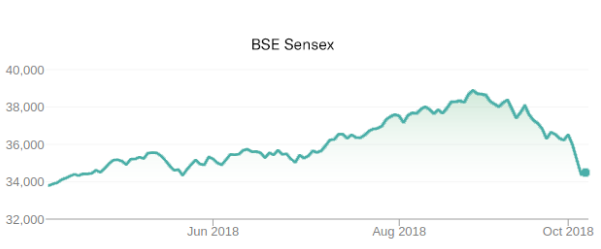Sensex crash has brought with it a wind of panic, confusion, and doubt in the mutual fund industry for investors. Most of them are in a state of shock and are worried regarding their investment. Mutual fund investments have always been tricky that often leads to good returns for those who are bold enough to remain invested under different situations. Wondering whether to remain invested or switch out of your investment? This blog is the answer.
Sensex also known as S&P BSE Sensex is the sensitive index that showcases the aggregate performance of 30 companies selected on the basis of different factors. A downfall in it affects the mutual funds’ performance as the investment here is made in stocks of companies. Let’s read about the recent changes in the Sensex and the reasons behind it.
Sensex in the Recent Times
As on August 28th, 2018, the Sensex reached its all-time high with 38896.63 points, bringing cheer in the stock market. Investors assumed that it will rise higher and may even cross 40,000 points but it happened otherwise. Recently, as on October 5th, 2018, it has dropped down to it lowest 34376.99.

What Are the Reasons Behind the Fall in Sensex?
There are a number of reasons which are responsible for the market crash that has taken place. They are as follows.
- Surging crude oil prices to $84/barrel is one of the main reasons behind the market downfall. It is because of persistent increase in crude oil prices that our import bills have pushed upwards, widened fiscal deficit and weighed the currency value. Evidencing it, as on October 08th, 2018 Indian rupee touched its all-time low of Rs. 73.768 signaling inflationary pressure on the Indian economy.
- Financial Institutional Investors have further withdrawn a large chunk of investments. This is a bad sign for the market, as this outflow has led to a further decrease in the value of rupee, thus dampening the market sentiments.
- Infrastructure Leasing & Financial Services (IL & FS) defaulted crores and is going through a serious liquidity crunch. In addition to this, the news of DSP Mutual Fund selling non-convertible debentures of DHFL at higher yields panicked the investors leading to a downfall in the bond market.
- In recent days, the 10-year bond yields in India have increased from 8.11% to more than 8.18% and been up by 84 basis points on YTD basis. This rise has further contributed to the exposure of rupee and equities to dollar outflows.
- The weakened Asian market as a result of good yield by the US and their economic data has even spread panic in the market.
- Yet another reason is the correction in mid cap and small cap space where most of the stocks have experienced their 52-weeks low.
How Can the Drop in Sensex Impact Mutual Fund Investors?
If you are an investor who has invested in mutual funds through SIP mode, then you don’t need to worry at all. This market downfall is the best time to remain invested. As, at low prices, more units can be purchased, thus leading to an overall balance of NAV at the time of maturity.
Golden Opportunity for All - When the market is low, it is a golden opportunity for any investor to invest in mutual funds. This is the best time to invest as the costlier stocks become available at cheaper rates. Thus, they get added to the investment portfolio of the mutual fund schemes which will benefit in the future.
Existing Ones Should Remain Invested - SIP investments don’t require timing the market as in the long run, the NAV gets balanced as a result of its feature of rupee cost averaging. The best way to face this situation is to be patient and remain invested.
The Bottom Line
As an Investor, you should note that although this time is good for investing, ensure that you add only those schemes which invest in quality stocks. Study carefully about the schemes you are choosing to invest in. Also, make sure that you are well aware of the risks involved. You may invest in mutual funds right now via MySIPonline, the online platform with simplified investment procedure. If you have any query further related to regular funds, you can either contact our financial experts or post the same here.













